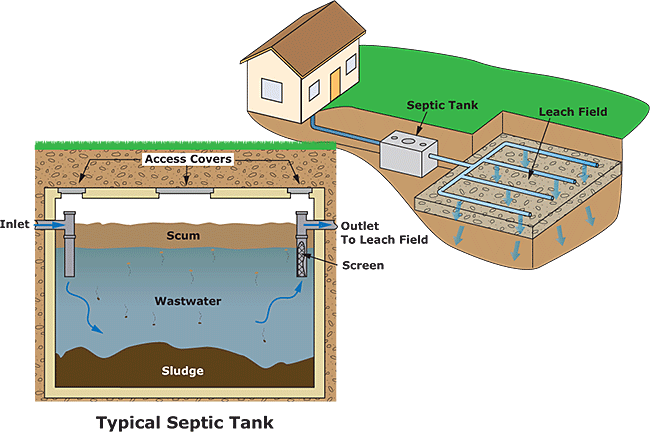

Chamber Septic Tank Systems ( Pressure Distribution, Gravel-less) Polyethylene plastic septic tanks make an excellent option for conventional gravity fed septic tank systems. Gravity based septic systems can require less regular maintenance or economic input when compared to other frequently used systems. Conditions such as a high groundwater table, high bedrock layer, and limited land space can make conventional septic tanks unsuitable or impractical for use and can indicate the need for a different system. In general, gravity systems require at least 3 feet of conducive subsurface soils beneath drain fields for post-septic tank fluid release and treatment. The total number and length of conventional drainage fields will depend on the scenario specifics. The septic tank then connects to a drain field for the distribution and further filtration of the septic tank wastewater effluent.Ĭonventional septic system drain fields are often underground trenches lined with stone, most commonly gravel, that creates the system’s leach field that is designed to complete waste breakdown through microorganism activity and underground geology. In this system, a decentralized septic tank, ( meaning located apart from the structure), receives blackwater and greywater influent from the property through gravity driven flow. No additional technology or electricity is required for a conventional system. The gravity fed septic system is so-called because it only uses the natural force of gravity to receive wastes from the property and make the system work. If you live in a home on a septic tank, chances are it is a conventional gravity fed septic system. Gravity fed septic systems are also one of the more simple, easier to install, and maintain of the possible system types. The Gravity Fed Septic System is the most common septic system type, and it is for this reason it is also known as a conventional system. Gravity Fed Septic Tank Systems ( Conventional) The following 5 septic system types are the ones most frequently chosen whenever a property requires the use of a septic tank. Polyethylene plastic septic tanks are fairly new compared to concrete septic tanks but provide many exclusive benefits and advantages and are acceptable for use in each of the different septic systems. While there are many types of functional and effective septic systems, there are five types that are used most often. Being standardized means each of the different septic system types are built similarly using the same principles each time. The specific installation and use of septic tanks and their systems has been standardized and is often overseen by regional guidelines, law codes, and/or permits. There are numerous septic system types and each has been designed according to location requirements of property size, regular water usage, and underground geological features such as depth of groundwater and makeup of the soil as to whether or not it is conducive to sufficient infiltration of the septic drainage to sustain operation of the system. Common reasons for needing a septic tank include local zoning requirements, physical location and distance, and other similar access restrictions all tied to whether a municipal sewer plumbing system is in the area or the cost of connecting to the sewer main. In general, septic systems are installed and used whenever the property lacks a connection to municipal provided sewer services. Septic tanks are used in residential homes, farms, businesses and industries. Some locations have a much higher percentage of septic system use, with some States averaging as much as 40% of residents or more on a septic tank. This value is a bit misleading, however, as it considers the entire United States as an average. federal research and data, anywhere between 20 to 30% of all American households use a septic system to handle human waste. The use of septic tanks and systems is fairly common in North America, and more so in rural areas. Septic tank systems are also known as onsite wastewater treatment, decentralized treatment, cluster systems, on-lot systems, and private sewage systems. Septic tanks are made for the storage, handling, breakdown and eventual release of human biowaste. The septic tank is a special application container used as the main part of a complete, onsite sewage waste management system.


 0 kommentar(er)
0 kommentar(er)
